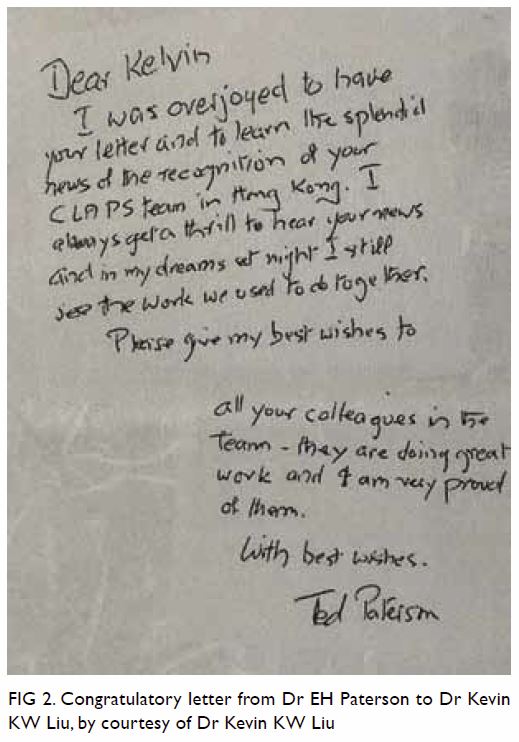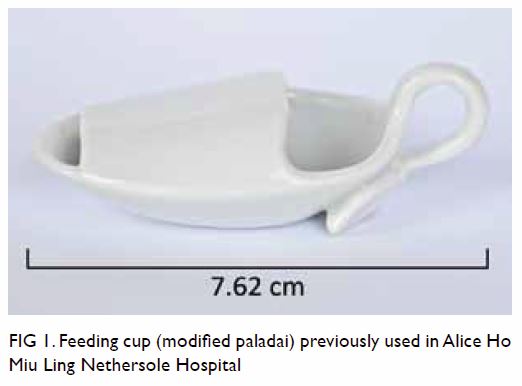© Hong Kong Academy of Medicine. CC BY-NC-ND 4.0
REMINISCENCE: ARTEFACTS FROM THE HONG KONG MUSEUM OF
MEDICAL SCIENCES
Paladai for feeding babies
YC Tsao, FHKAM (Paediatrics), FRCPCH
Member, Hong Kong Museum of Medical Sciences
Society
The paladai is a cup-like utensil with a narrow tip
that has been used traditionally to feed babies in India1 when the mother
cannot breast feed. It is used to hold expressed breast milk or other
types of liquid or semi-solids. The baby is held reclining while being
fed. The narrow tip makes it easier to place the paladai into the baby’s
mouth. It is also easier to clean after use than a feeding bottle and is
usually made of metal so that it is not easily broken.
The cup in the Museum’s collection (Fig
1), on permanent loan from the Alice Ho Miu Ling Nethersole Charity
Foundation, is similar to the paladai but has a curved hood over the top
to lessen spillage, and is ceramic. It is probably a European version of
the paladai. In the past, the hood was also added to some of the spoons
used to feed babies with cleft palate, but this has now gone out of
fashion.
Babies with cleft palate are difficult to feed for
two main reasons. First, they cannot create a vacuum in the mouth to suck.
Second, the milk can easily enter the nasal cavity and cause irritation.
Various devices have been used to help make feeding
easier. While some use a narrow spoon to place the feed into the baby’s
mouth, others use a cup. The paladai may be regarded as a special cup used
for this purpose. Some used a syringe pump with a rubber tube at the tip.
Various specially designed bottles and nipples have also been used such as
the Medela Special Needs feeder (formerly called Haberman feeder after its
inventor),2 the Dr Brown’s bottle,3 and the Pigeon nipple.4 All use a
one-way valve to keep the nipple filled. Pressure on the nipple prompts
milk flow into the mouth and release of pressure allows the nipple to be
refilled from the bottle. The Haberman design has a compressible neck
between the teat and the bottle, which can be controlled by the feeder.
The Dr Brown’s specialty bottle comes with a one-way valve for the nipple
and an air-vent for the bottle to reduce the air that the baby swallows as
it feeds. The Pigeon nipple has only a one-way valve and can be used with
an ordinary milk bottle. The Enfamil Cleft Lip/Palate Nurser uses a
compressible bottle to control milk flow and may be used with an ordinary
nipple with the hole widened by a crosscut.
Feeding milk from a bottle is now a preferred
method of feeding for babies with cleft palate, as it makes the whole
feeding process look more normal. To minimise milk entering the nasal
cavity, it is usually advised to hold the baby in a semi-upright position.
Dr Edward Hamilton Paterson came to Hong Kong in
1951. He began his career in Hong Kong as the senior surgeon of Alice Ho
Miu Ling Nethersole Hospital, and became medical superintendent in 1963.
As a surgeon, he took a special interest in cleft lip and palate surgery.
He devised the heptagon operation for repair of bilateral cleft lip.5 In
those days I was in awe of the excellent results of repairs done by Dr
Paterson in patients who came to see me. He became the medical
superintendent of the new United Christian Hospital in 1972 when it opened
in Kwun Tong. There, he advocated the concept of a ‘hospital without
walls’, an initiative to extend patient care beyond the hospital into the
community. Relying on outside funding, he established the community
nursing service in Hong Kong that was subsequently taken over by the
government and recognised as a model of good practice. Such a care model,
among many other works, helped him earn the degree of Doctor of Social
Sciences, honoris causa, conferred by The University of Hong
Kong,6 as well as Justice of the Peace and OBE by the Hong Kong
Government. Although administration took up much of his time, he
nevertheless continued to develop the service for individuals with cleft
lip and malformed palate. In addition, he pioneered a team approach in the
care of such children, involving a surgeon, speech therapist, and dentist.
The service and the multidisciplinary approach were further expanded by Dr
Kevin KW Liu, who joined United Christian Hospital in 1997. In 2010, the
team was recognised by the Hospital Authority as a Centre of Excellence
for the management of children with severe cleft deformity and in the
following year won the Outstanding Team Award. Dr Paterson was overjoyed
when he heard the news, as it was part of his legacy (Fig
2).

Figure 2. Congratulatory letter from Dr EH Paterson to Dr Kevin KW Liu, by courtesy of Dr Kevin KW Liu
Patterns of care and utensils may change, but the
paladai from the Alice Ho Miu Ling Nethersole Hospital will remind us of
its past use and it may still be useful as a form of cup feeding for many
years to come.
References
1. Paladai-infant feeding cup. Available
from: https://www.flickr.com/photos/prasadtr/14640566012. Accessed 15 Dec
2017.
2. Haberman M. How to use Haberman feeder
by Mandy Haberman. 2010. Available from: https://www.youtube.com/
watch?v=dTXafdt1Ykw. Accessed 15 Dec 2017.
3. Dr. Brown’s medical specialty feeding
system. Available from: https://www.drbrownsbaby.com/medical/products/
specialty-feeding/. Accessed 15 Dec 2017.
4. Cleft feeding instructions by Seattle
Children’s Hospital. Available from:
http://www.seattlechildrens.org/clinics-programs/craniofacial/patient-family-resources/cleft-feeding-instructions/.
Accessed 15 Dec 2017.
5. Royal College of Surgeons: Plarr’s Lives
of the Fellows Online. Bibliographical entry: Paterson, Edward Hamilton
(1920-2013). Available from:
https://livesonline.rcseng.ac.uk/biogs/E005167b.htm. Accessed 15 Dec 2017.
6. The University of Hong Kong Honorary
Degrees Congregation in 1985. Edward Hamilton Paterson, Doctor of Social
Sciences honoris causa. Citation by the Public Orator Professor
Francis Charles Timothy Moore.


